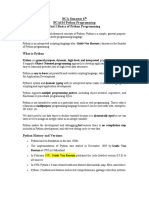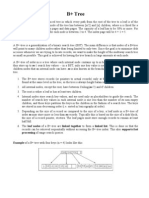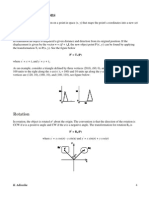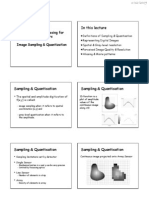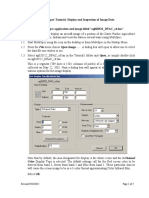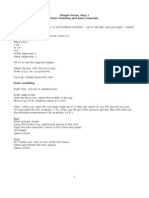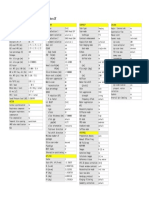Fundamentals of
Digital Imaging
Part 1
Digitizing Images
�In this lecture, you will find
answers to these questions
What does digitizing images mean?
How are images sampled and quantized in the
digitization process?
How are pixels, image resolution, and bit depth related
to sampling and quantizing?
How do the choices of the sampling rate and bit depth
affect the image fidelity and details?
2
�Digitization
To convert analog information into digital data that
computers can handle
2-step process:
1.
sampling
2.
quantization
�Sampling
�Pegboard Analogy
A 10 holes 10 holes pegboard
5
�Pegboard Analogy
Suppose you want to copy this music note graphic on the pegboard.
6
�Pegboard Analogy
Suppose we only put a peg in a hole if more than half of its area is
covered by the musical note graphic.
7
�Pegboard Analogy
When we remove the musical note overlay, details are lost because
the grid is too coarse for this musical note.
8
�How would you
improve the details
of the musical
notes on the
pegboard?
�Using a pegboard with more
holes
When there is more holes in a pegboard, the hole size will be
smaller and more peg will be used to cover the whole area of
10
musical note graphic.
�Using a pegboard with more
holes
Now it looks closer to the original musical note.
11
�Pixels
Each hole on the pegboard is a sample point.
The sample points are discrete.
In digital imaging, each of these discrete sample
points is called a picture element, or pixel for short.
Remember!
A pixel is a sample point.
It does not really have a physical dimension
associated with it.
12
�Pixel Dimensions
Refer to an images width and height in pixels
In the pegboard analogy, the dimension of this
pegboard would be 10 holes 10 holes.
13
�Sampling Step
Analog data
Discrete data
Sampling step a 2-dimensional grid is applied on the14
image and each tiny cell on the grid is converted into a pixel
�Another example
A natural scene
Imagine that you are going to
capture this view on a pegboard.
Sample into a grid of
25 20 discrete samples
Suppose you are going to sample the
scene you see into a pegboard with
25 20 holes.
15
�Sampling Rate
Refers to how frequent you take a sample
For example, when we change the grid from 25
20 to 100 80, we say that we increase the
sampling rate.
You are sampling more frequently within the
same spatial distance.
16
�Resolution
In digital imaging, increasing the sampling rate is
equivalent to increasing the image resolution.
With higher resolution,
You have more sample points (pixels) to represent
the same scene, i.e., the pixel dimensions of the
captured image are increased.
You gain more detail from the original scene.
But!
The file size of the digitized image is larger.
17
�Resolution of Digital Photos
Note that 25 20 and 100 80 pixels are by no
means realistic pixel dimensions in digital
photography. They are only for illustration
purposes here.
Most digital cameras can capture images in the
range of thousand pixels in each dimensionfor
example, 3000 pixels 2000 pixels= 6megapixels
18
�Digitization
19
�Colors
A natural image is colored in continuous tones, and thus
it theoretically has an infinite number of colors.
The discrete and finite language of the computer
restricts the reproduction of an infinite number of
colors and shades.
20
�Quantization Step
To encode an infinite number of colors and shades with
a finite list.
Quantizing the sampled image involves mapping the
color of each pixel to a discrete and precise value.
21
�Quantization Step
First, you need to consider how many possible
colors you want to use in the image.
To illustrate this process, lets take an example of
100 80 sampled image.
22
�The sampled 100 80 image
23
�Say, we want to map the color of each
sample points into one of these four colors:
24
�Quantized with 4 Colors
25
�Quantized with 8 Colors
26
�Consequences of
Quantization
Reduce the number of allowed colors in the image.
When we reduce the colors, different colors from
the original may be mapped to the same color on
the palette. This causes the loss of the image
fidelity and details.
The details that rely on the subtle color differences
are lost during quantization.
27
�The same area in the 4-color
image now has only one color.
The area outlined in red is made
up of many different green colors.
28
�Bit Depth
The number of colors used for quantization is
related to the color depth or bit depth of the
digital image.
A bit depth of n allows 2n different colors.
Examples:
A 2-bit digital image allows 22 (i.e., 4) colors in
the image.
An 8-bit digital image allows 28 (i.e., 256)
colors in the image.
The most common bit depth is 24. A 24-bit image
allows 224 (i.e., 16,777,216) colors.
29
�Will increasing the number of
colors in the palette improve the
image fidelity?
It depends, and in most cases, can be yes.
The number of colors or the bit depth is not the
only determining factor for image fidelity in
quantizing an image.
The choice of colors for the quantization also
plays an important role in the reproduction of an
image.
30
�Quantized with 8 Different
Colors
31
�Effect of Bit Depth on File
Size
Higher bit depth means more bits to represent a
color.
Thus, an image with a higher bit depth has a
larger file size than the same image with a lower
bit depth.
32
�Lets review this topic!
What does digitizing images mean?
How are images sampled and quantized in the
digitization process?
How are pixels, image resolution, and bit depth
related to sampling and quantizing?
How do the choices of the sampling rate and bit
depth affect the image fidelity and details?
33
�Reference:
"Digital Media Primer" Yue-Ling
Wong,
Copyright (c)2013 by Pearson
Education, Inc. All rights reserved.
Chapter 2
34






